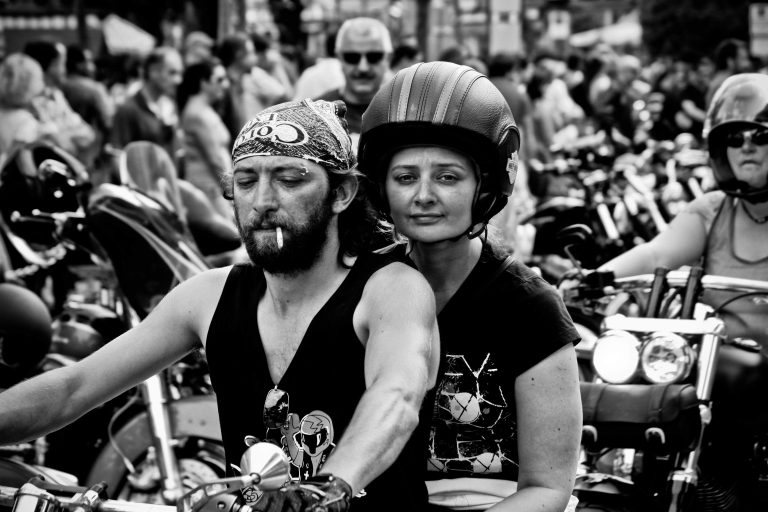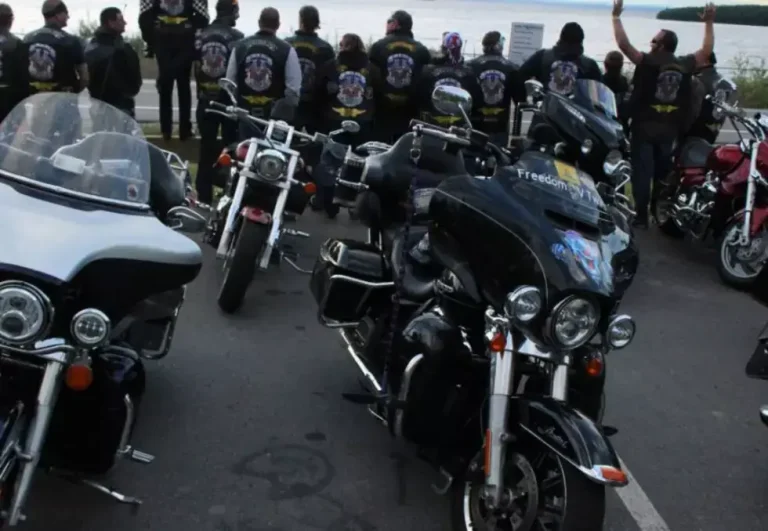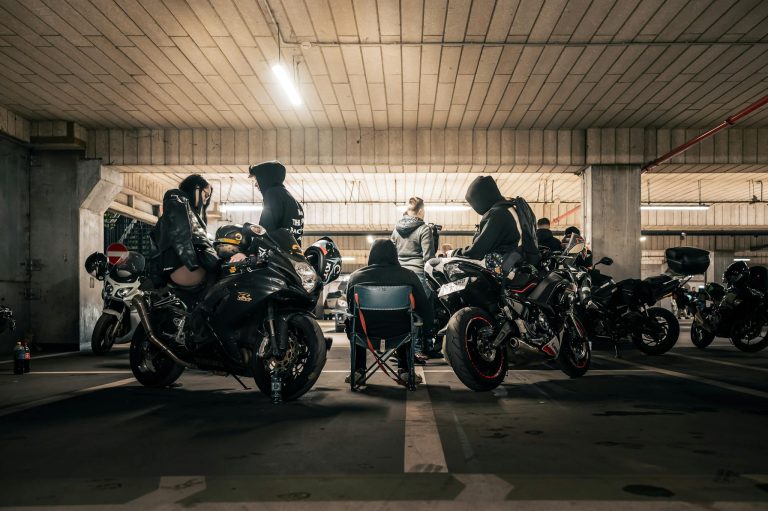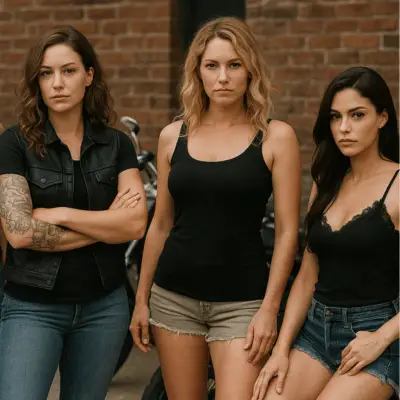When most people hear “outlaw motorcycle club,” they picture the gritty world of Sons of Anarchy, outlaw bikers roaring through town, running guns, and leaving chaos in their wake. The show cemented the idea that MCs are little more than criminal brotherhoods bound by violence and rebellion.
It’s dramatic, it’s entertaining, and it makes for great TV, but how much of it is true? Outside the Hollywood spotlight, real motorcycle clubs look very different. They’re about lifelong bonds, charity rides, service to their communities, and a code of honor that outsiders rarely see. These stereotypes risk misunderstanding an entire culture built on respect, loyalty, and the open road, and intensifying public anxiety.
The Big Bad Biker Myth
One of the biggest outlaw biker myths and probably the one all the others feed off, this is the one that is causing alot of that public anxiety. Newspapers, Authorities, Hollywood, Books, and TV shows all love this one and perpetuate it over and over.
The big bad biker persona, let’s break it down piece by piece:
The outlaw image; this one is partly grounded in truth, outlaw bikers do live by their own rules, they are rebels, and the heart of the problem is that this has been twisted to mean violent or criminal, which isn’t the case in the majority. Some clubs or members may get involved in crime that is normally a matter of income revenue rather than a desire to be criminal and break the law.
Violence & Intimidation: Violence is a funny one because, of course, we are not saying all outlaw bikers are saints, and it would be wrong and misleading to paint them as such. Everyone knows that the outlaw biker world can be a dangerous place, but the myth that all outlaw bikers are quick to violence is a Hollywood myth.
It was outlined clearly in the movie The Bikeriders. The character Johnny, played by Tom Hardy, was portrayed as quick to violence. Still, in reality, Johnny, aka Johnny Davis, the founder of The Outlaws MC, wasn’t quick to violence, like most; he did what needed to be done when it needed to be done.
One of the reasons the Outlaws MC didn’t endorse the film was because of the inconsistency in its representation of the truth. The violence usually occurs when a situation escalates out of control, and normally, attempts have been made to settle the issue beforehand. Although turf wars and bar brawls happen is alot less often than you’d think. This idea of intimidation is a farce.
We don’t believe any club sets out to intimidate another or the public; the kuttes are about honour and identity. The MC sphere vibes on respect always, and in the same way that a soldier doing initial training isn’t gonna fight (if he’s smart) with a SAS officer, because he knows they’re better trained and have more experience in the field, and he’ll get his ass kicked.
It’s the same thing, a small club knows if they pick a fight with a dominant diamond club, they’d better be prepared to get everyone’s ass kicked. The fake intimidation that the public faces is fueled by Hollywood and media, and in part perpetuated by the gear an outlaw biker wears, you move differently in biker gear, plus alot of these guys tend to be quite stoic, and in combination, run the risk of being misunderstood.
We’ve already touched on the criminal enterprises; outlaw motorcycle clubs are not criminal organizations, but they may have individuals within them who carry out illegal activities independently. Where clubs get in trouble with the law, it is normally for one of two reasons: a criminal activity was presented as a viable income stream that couldn’t be replicated another way, or a situation that got out of control and couldn’t be solved peacefully.
Appearance, another huge misconception, authorities, media, Hollywood, and even the public like to imagine that some of the symbols used in insignia, tattoos, and clothing are designed to instill fear and intimidation, so let’s break down a few things first of all, skulls or skeletal bones, in MC culture these are used to represent that we are all equal in death. We are not gonna excuse loud bikes it’s a choice, outlaw bikers like loud bikes there’s no intention behind it, and honestly the bike isn’t a danger to you to start with that biker loves that bike more than you love your dog, and two that bike is essentially a flaming tank of gas, there is more chance of the rider hurting than himself using it as a weapon against you.
Clothing, a biker can’t move the same in biker clothing as someone in plain clothing, it’s a physical impossibility, so the way a biker moves is in part related to what gear he’s wearing, because at the heart of it, he needs to be able to get up and get home after a crash. While clothing is getting better, all clothing has special materials, inserts, and safety padding. Street bikers particularly need gear with abrasion and impact protection because of the high impact and sliding that occurs when you come off the bike, which means pads and inserts, and strong boots. A biker doesn’t care about intimidating you, and definitely doesn’t choose clothing for that purpose.
Antisocial behavior & masculinity. Honesty, we have to call nonsense on this one, what society is really saying is that a bunch of grown men siting on corner or chatting on a village green, is somehow a method of spreading chaos its actually the opposite they’re either socialising and bonding or when you see a group on a corner with all the bikes they are guarding the bikes to ensure they don’t get stolen ( have you seen the state of bike theft crime rates?).
Let’s talk about masculinity – there’s nothing wrong with masculinity, but it gets twisted, this idea that bikers are tough, domineering, emotionally detached, and only treat women like possessions. Let’s just play along a second, if the first were true, that would make the women who approach them, and stay around, either extremely brave or extremely tough, and definitely would not lead evidence to the theory that women are badly treated within outlaw motorcycle clubs.
The truth is bikers come from all walks of life; some may be domineering, some are tough, but it isn’t a standard; in fact, if there’s any standard, it’s to ride a bike and think out of the box. Women are treated with respect and highly protected within the outlaw motorcycle culture, and it’s time society stopped trying to twist this into something toxic.
Nomadic lifestyle. This is another flight of fancy, created by Hollywood, that somehow these bikers are rootless troublemakers just wandering, looking for the next situation to get into. It just doesn’t exist. The one thing that distinguishes the outlaw biker culture from other lanes in the biker community is the high level of discipline, structure, and tradition. Essentially, the club is a business, and there’s work to be done to keep it running. You’ll often hear the phrase “put the work in,” or similar, we talk about alot. Even the bikers who hold the position of Nomad or are part of a Nomad chapter don’t wander around aimlessly;they often have assignments helping different chapters in a club out.
Alot of the other myths are wrapped up in what we’ve discussed here. If you’ve lived inside the outlaw motorcycle club sphere, you’ll know they can easily be debunked. This idea, for instance, that it’s constant violence, constant crime like on TV, most will tell you no, while those things may exist, they are not regular occurrences.
Reality of MC Culture
Nothing quite compares you to the inside of the outlaw motorcycle club culture, as much as you think you know what you’re getting into, there are too many variables, the multiple personalities in the group, the inner politics, the military level structure, the history and traditions, and this is before we get to the brotherhood – the bond that should be unbreakable even that varies from one club to another, while community, family and given high importance charity rides, helping the community, is all apart of day to day life but is rarely shouted about its the silence work that happens for good of the community, annual events, rides, and parties day to day work and ongoing training, riding in formation of a club is very different to just hitting the highway, your club rules become law and breaking them has consequences (not always violent, sometimes, there are small conquences,)
Codes of conduct and ethics vary from club to club. If you want to be in the life, you can expect to ride alot, work on your bike and riding skills alot, be on call to help out in the club for whatever it needs, prepare for bonding and socialising, and do community work. The best thing you can remember is to be teachable; everything is a lesson inside a club, and sometimes you’ll have to figure out what the lesson is.
One of the main aims of Kutte Kulture Ltd, Grim Rider Magazine, and GAOP is the championing of the truth. Authenticity is very important to us, so much damage has been caused not just to the outlaw biker community, but to the general public by the spread of false narratives and misconceptions. We believe it’s all in the name of control and power trips; there would be no public anxiety if there were no false narratives.
Why Stereotypes Persist
We live in a world where we are being conditioned pretty much from birth, and the stereotypes are as old as the outlaw motorcycle club culture. The very act of riding a motorcycle is considered rebellious, living on the fringe of society and therefore society’s norms and rules.
In a world where authorities seek power and control over society’s members, motorcyclists become the number one enemy. Hollywood, the media, and local authorities are all to blame for perpetuating the stereotypes and false narratives, while, in part, the media draws its narrative from the authorities, creating a never-ending cycle.
But we all have a role to play in the secrecy of the outlaw motorcycle club sphere, although needed for protection and security in a dangerous world, it does little to dismiss the false impressions put on the local public. The iconic silence in the wake of negative events also contributes, because there’s no one to speak against the false narratives in the moment.
The truth of it is the stereotypes and false narratives make for sensational headlines, movies, TV, and articles – in short, it’s a bit like the selling sex argument, it makes the media industry alot of money, especially when you consider that given the secrecy and dangerous stereotype, the whole world is obsessed with motorcycle culture.
Add to this the fact that people are now raised on screens, we live in a world where people view media as reality, and while all media is simply a representation of something from a specific perspective. The human brain doesn’t distinguish between fact and fiction; it simply takes in information and stores it, for future use, i.e, when it hits a situation it needs a solution for it searches the information store. Your brain is capable of hallucinations in the same way ChatGPT does.
Outsiders are particularly vulnerable to misconceptions and understandings because they have no knowledge to cross-reference, they have no knowledge of the world inside outlaw motorcycle clubs, so they compare the stereotypes and things they hear true or not, to their world and their limited knowledge of it. The problem is that the two worlds are not compatible.
The Consequences for outlaw motorcycle clubs are huge, and the culture is waking up to this with more platforms speaking out on it. Let’s just take the gang label, the authorities love to label motorcycle clubs as gangs or OMCGs, and terms that don’t really exist other than for their classification, while on the surface to many this seems like an inconvenience, its not it allows the authorities, to use organized crime laws and procedures against the clubs even when a crime hasn’t been committed. RICO laws are famously used in the UK. To demonstrate this, if a motorcycle club member ran a red light and prosecutors applied RICO laws, that simple traffic violation could suddenly be treated like organized crime, potentially carrying years in prison instead of just a ticket. Also, Organized crime laws support profiling, monitoring, and the targeting of anyone associated with that group.
But, beyond the legal protection, there are consequences like finding it hard to make friends, being accepted in society, and even working. Belinda recalled this memory from her father while he was working in London for a courier company. A new, larger company had taken over when the motorcycle couriers walked into the office. Instead of putting them to work, they phoned the previous owners and said,
“I have a bunch of ‘Hells Angels’ (none of them actually were) in the office, what the hell am I supposed to do?” The owner was shocked when the reply came
“I suggest you put them to work because there’s nothing those boys can’t shift.”
The whole thing kind of fell apart when they started insisting on changes in appearances, and the boys walked only to be rehired when the owner realised he couldn’t exist without them.
It’s just another example of how, as a biker, the false narratives can affect your life. And everybody in the life has a story.
How Kutte Kulture Counters Myths
Kutte Kulture Ltd exists to set the record straight. Too often, TV and news reduce bikers to criminals and chaos. We flip that script by showing what MC life is really about: brotherhood, respect, community service, and freedom on the open road.
Through our magazine and platform, we dive into the history, values, and everyday realities of motorcycle clubs. We run interviews and profiles with riders who’ve built legacies, spotlight charity work that rarely makes headlines, and publish reader stories that bring diverse voices to the table.
We also defend the culture. Our legal rights hub challenges unfair practices and arms bikers with the knowledge they need. At the same time, our focus on gear, traditions, and kuttes celebrates the pride and identity that come with riding.
Connection matters, too. That’s why we offer a Find a Club directory, host workshops, and run campaigns to educate both clubs and the public.
By calling out myths and amplifying truth, Kutte Kulture protects the image of MC culture and pushes it forward, authentic, respected, and stronger than ever.
Frequently Asked Questions
1. Are outlaw motorcycle clubs really criminal gangs?
No. While some individuals may commit crimes, the majority of outlaw motorcycle clubs are not criminal organizations. Clubs focus on riding, brotherhood, tradition, and community service. The “gang” label is a stereotype perpetuated by authorities and media.
2. Why are bikers seen as violent or intimidating?
Hollywood often portrays bikers as quick to violence, but in reality, most conflicts are avoided or resolved before they escalate. Kuttes, tattoos, and biker gear can look intimidating, but they’re symbols of honor, identity, and safety, not aggression.
3. Do bikers dress to scare people?
Not at all. Biker clothing is designed for safety, not intimidation. Heavy boots, armored jackets, and reinforced gear protect riders from crashes. The way bikers move in this gear may appear intimidating, but it’s a necessity for survival on the road.4. Is the “nomadic outlaw biker” a real lifestyle?
No. The idea of rootless bikers drifting from fight to fight is a Hollywood invention. In reality, MCs are highly structured, disciplined, and community-focused. Even though Nomad members work on assignments to support different chapters, they don’t wander.
Conclusion
Motorcycle clubs have long been judged through the narrow lens of media stereotypes, loud, dangerous, and defined by crime. But the real culture tells a different story: one of loyalty, service, and a shared love of the ride. By taking time to understand the values, history, and contributions of MCs, we begin to see riders not as myths but as people with traditions worth respecting.
Cultural understanding matters. When we move past surface-level portrayals, we not only challenge unfair narratives but also strengthen connections between bikers and the communities they call home. So next time you hear the roar of engines, look beyond the leather and patches. Behind every kutte is a story of belonging, pride, and brotherhood that deserves to be seen for what it truly is.




